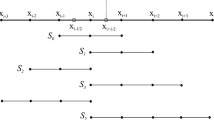Abstract
The paper argues that to achieve the desired width of applicability for use in general CFD software, turbulence modelling at second-moment level needs to be based upon making the pressure-strain term and other major processes comply with the two-component limit (TCL), a strategy first advocated by Lumley [24]. The approach is especially powerful for flows close to surfaces that are far from flat and in applications to horizontal, stably-stratified flows where, due to the action of buoyancy, the stress tensor also approaches a two-component form.
A range of recent applications of TCL modelling is presented including flow in curved ducts, three-dimensional wall jets, free-surface jets and stably-stratified mixing regions.
Similar content being viewed by others
References
Abrahamsson, H., Johansson, B. and Löfdahl, L., An investigation of the turbulence field in the fully developed three-dimensional wall-jet. Technical Report Internal Report 97/1, Chalmers University of Technology, Sweden (1997).
Chang, S.M., Humphrey, J.A.C. and Modavi, A., Turbulent flow in a strongly curved U-bend and downstream tangent of square cross section. Phys. Chem. Hydrodyn. 4 (1983) 243–269.
Chou, P.-Y., On velocity correlations and the solution of the equations of turbulent fluctuations. Quart. Appl. Math. 3 (1945) 38–54.
Craft, T.J., Second-moment modelling of turbulent scalar transport. Ph.D. Thesis, Faculty of Technology, University of Manchester (1991).
Craft, T.J., Developments in a low-Reynolds-number second-moment closure and its application to separating and reattaching flows. Internat. J. Heat Fluid Flow 19 (1998) 541–548.
Craft, T.J., Ince, N.Z. and Launder, B.E., Recent developments in second-moment closure for buoyancy-affected flows. Dynam. Atmosph. Oceans 23 (1996) 99–114.
Craft, T.J., Kidger, J.W. and Launder, B.E., Importance of third-moment modelling in horizontal, stably-stratified flows. In: Proceedings 11th Turbulent Shear Flows Symposium, Grenoble (1997) pp. 20–13–20–18.
Craft, T.J., Kidger, J.W. and Launder, B.E., Second-moment modelling of developing and selfsimilar three-dimensional turbulent free-surface jets. Internat. J. Heat Fluid Flow 21 (2000) 338–344.
Craft, T.J. and Launder, B.E., The self-similar, turbulent, three-dimensional wall jet. In: Banerjee, S. and Eaton, J. (eds), Turbulence and Shear Flow Phenomena-1, Begell House, New York (1999) pp. 1129–1134.
Craft, T.J. and Launder, B.E., On the spreading mechanism of the three-dimensional turbulent wall jet. J. Fluid Mech. 435 (2001) 305–326.
Craft, T.J. and Lien, F.-S., Computation of flow through a circular to rectangular transition duct using advanced turbulence models. In: Proceedings 4th ERCOFTAC/IAHR Workshop on Refined Flow Modelling, Karlsruhe, Germany (1995).
Davis, D.O. and Gessner, F.B., Experimental investigation of turbulent flow through a circularto-rectangular transition duct. AIAA J. 30 (1992) 367–375.
Durbin, P.A., A Reynolds stress model for near-wall turbulence. J. Fluid Mech. 249 (1993) 465–498.
Fu, S., Computational modelling of turbulent swirling flows with second-moment closures. Ph.D. Thesis, Faculty of Technology, University of Manchester (1988).
Gibson, M.M. and Launder, B.E., Ground effects on pressure fluctuations in the atmospheric boundary layer. J. Fluid Mech. 86 (1978) 491–511.
Hinze, J.O., Experimental investigation on secondary currents in the turbulent flow through a straight conduit. Appl. Sci. Res. 28 (1973) 453.
Iacovides H., Launder, B.E. and Li, H.-Y., Application of a reflection-free DSM to turbulent flow and heat transfer in a square-sectioned U-bend. Exper. Thermal Fluid Sci. 13 (1996) 419–429.
Johnson, R.W. and Launder, B.E., Local heat transfer behaviour in turbulent flow around a 180 bend of square cross section. Internat. J. Heat Fluid Flow 6 (1985) 171–180.
Kidger, J.W., Turbulence modelling for stably stratified flows and free surface jets. Ph.D. Thesis, University of Manchester Institute of Science and Technology (1999).
Launder, B.E., Second-moment closure: present... and future? Internat. J. Heat Fluid Flow 10 (1989) 282–299.
Launder, B.E. and Li, S.-P., On the elimination of wall-topography parameters from secondmoment closure. Phys. Fluids 6 (1994) 999–1006.
Launder, B.E. and Tselepidakis, D.P., Contribution to the modelling of near-wall turbulence. In: Durst, F., Friedrich, R., Launder, B.E., Schmidt, F.W., Schumann, U. and Whitelaw, J.H. (eds), Turbulent Shear Flows, Vol. 8. Springer-Verlag, New York (1993) pp. 81–96.
Leschziner, M.A., Batten, P. and Loyau, H., Modelling shock-affected near-wall flows with anisotropy-resolving turbulence closures. Internat. J. Heat Fluid Flow 21 (2000) 239–251.
Lumley, J.L., Computational modelling of turbulent flows. Adv. Appl. Mech. 18 (1978) 123–176.
McGuirk, J.J. and Papadimitriou, C., Buoyant surface layers under fully entraining and internal hydraulic jump conditions. In: Proceedings 5th Symposium on Turbulent Shear Flows, Cornell University (1985) pp. 22.33–22.41.
Rajaratnam, N. and Humphries, J.A.C., Turbulent non-buoyant surface jets. J. Hydraulic Res. 22 (1984) 103–115.
Reece, G.J., A generalised Reynolds stress model of turbulence. Ph.D. Thesis, Faculty of Technology, University of London (1977).
Rotta, J., Statistische Theorie nichthomogener Turbulenz. Zeitschr. Phys. 129 (1951) 547–572.
Schumann, U., Realizability of Reynolds stress turbulence models. Phys. Fluids 20 (1977) 721–725.
Shih, T.-H. and Lumley, J.L., Modeling of pressure correlation terms in Reynolds stress and scalar flux equations. Technical Report FD-85–03, Sibley School of Mechanical and Aerospace Engineering, Cornell University (1985).
Shir, C.C., A preliminary numerical study of atmospheric turbulent flows in the idealised planetry boundary layer. J. Atmos. Sci. 30 (1973) 1327–1339.
Uittenbogaard, R.E., Measurement of turbulence fluxes in a steady, stratified, mixing layer. In: Proceedings 3rd International Symposium on Refined Flow Modelling and Turbulence Measurements Tokyo, Japan (1988) pp. 725–732.
Author information
Authors and Affiliations
Rights and permissions
About this article
Cite this article
Craft, T., Launder, B. Principles and Performance of TCL-Based Second-Moment Closures. Flow, Turbulence and Combustion 66, 355–372 (2001). https://doi.org/10.1023/A:1013514632684
Issue Date:
DOI: https://doi.org/10.1023/A:1013514632684




